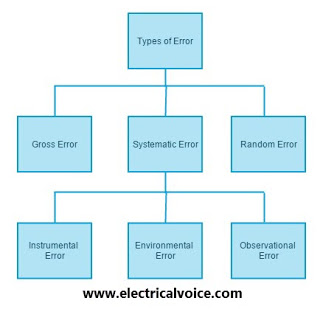In this article, we will understand the concept of errors in measurement, types of errors in measurement in detail. This is most important and starting topic in measurements.
True Value
Contents
show
It is defined as the average value of an infinite number of measured values when average deviation due to various contributing factor approaches to zero. It is not possible (or impossible) to determine the true value of quantity by an experiment means.
Measured Value
It is the approximated value of a true value of a quantity. It can be found by taking a number of readings of an experiment taking into different physical parameters and conditions.
Static error
The static error is defined as the difference between the measured value and the true value of the quantity.
Mathematically, the static error is written as,
ẟA = Am − At
where, ẟA is the static error
Am is measured value,
At is true value
Note: The absolute value of error cannot be determined because of the fact that the true value of quantity cannot be determined accurately.
Static Correction
Static Correction may be defined as the difference between the true value and the measured value of the quantity.
Mathematically, the Static Correction is written as,
ẟC = At − Am
or
ẟC = − ẟA
Limiting Errors or Guarantee Errors
It is an error that the manufacturer promises that the error in the instrument or item he is selling is no more than the specified limit. For example, a resistor has limiting error of ± 9 Ω.
The magnitude of a resistor having nominal value 200 Ω will be between 200-9 Ω and 200+9 Ω This means that the manufacturer guarantees that the value of resistance of the resistor lies between 191 Ω and 209 Ω.
Relative Error or Fractional Error
A relative or fractional error is defined as the ratio of the error and the specified (or nominal) magnitude of the quantity. It is denoted by  .
.
 .
.
Types of Errors
There are 3 types of error in measurement.
- Gross Error
- Systematic Error
- Random Error
1. Gross Error
This type of error arises due to human mistakes during reading, recording and calculating measurement values from an instrument. Suppose a person reads 12 as 21 by mistake then this type of error is called Gross error.
A gross error can be avoided by two methods.
- A user should care while taking reading and recording measurement values.
- Secondly, the user should take a number of reading of an experiment. After that taking average value of whole experiments will reduce the gross error.
2. Systematic Errors
As shown in the above chart, systematic Errors are classified into 3 types as
- Instrumental Errors
- Environmental Errors
- Observational Errors
a). Instrumental errors arise mainly due to inherent shortcomings in the instruments, loading effect of instrument or misuse of an instrument.
b). Environmental errors arises due to instrument external conditions like pressure, temperature, vibrations, humidity, magnetic or electric fields, etc.
c). Observational errors arise due to human inability to read value correctly. One such example is Parallax. Another example is no two person observe the same situation in the same way. There will always some small deviation in the values measured by the two persons.
3. Random Errors
These are the errors that are left after Systematic errors. These errors come in the reading without their source known. These errors are also called residual errors.



Thanks
Thanks its been helpful in my research in measurement